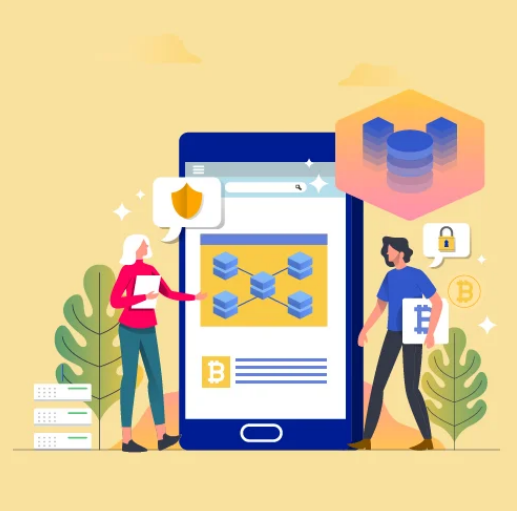A Digestible Guide to Blockchain App Development
 James Smith
James Smith
From news channels to social media platforms and the office group discussions, blockchain has remained the hottest topic for past some years now. And still, there’s no sign that the noise around the blockchain and cryptocurrencies is going to die down anytime soon. And so, we are here with this blockchain app development guide to help you with all the major technical and business aspects of the technology.
With lots of fans and critics, blockchain technology news, with its apps and blockchain development tools are growing in popularity to unimaginable heights. It is becoming the buzzword where even a normal company changing its name and business model according to the blockchain hype is leading to higher profits.
Have any doubt? Let’s clear out!
A UK based organization, On-Line PLC gained significant traffic, higher proposals from investors and share price surge by 394% by just changing its name to On-Line Blockchain PLC.
We know it can be hard to digest? Just have a look at these statistics then,
In 2017, the blockchain market was about $339.5 billion in size whereas it is forecasted to cross $2.3 billion by 2021.
According to statistics by Dot Com Infoway, the global blockchain market is expected to be worth $20 billion in the year 2024.
According to Grand View Research, the global blockchain technology market size was valued at USD 3.67 billion in 2020. It is expected to expand at a compound annual growth rate (CAGR) of 82.4% from 2021 to 2028.
There will be 42.8% blockchain growth per year till 2022 and the main catalyst behind this upliftment will be blockchain adoption in money exchange and growing interest of world’s top banks in creating cryptocurrencies like Utility Settlement Coin (USC) to ensure better cross-border transactions.
71% of business leaders using blockchain, as a report, believe that it will play a pivotal role in advancing the technology, resulting in widespread support for industry standards.
With these mind-boggling stats, it is clear to you that developing Blockchain app and building blockchain projects are soaring as a business focus for several startups and established businesses. From manufacturing to media, telecommunications, finance, banking, healthcare, energy, real estate, and even the government sector is showing interest in the production of Blockchain application development.
So, are you prepared for the revolution called Blockchain Apps Development?
Though Blockchain is a tech breakthrough megatrend with unmatchable potential in the future, it will be completely impractical to invest in blockchain software development with the fear of missing out, without a clear understanding of how can it be useful for your business – something that Blockchain app builders can help you get a clear idea of.
So, in the Blockchain technology development Guide, we will cover the technical aspect of the Blockchain technology along with the ways you can integrate blockchain into your business processes in this article And in case you need something more specific to a business handbook, head on to our personalized Blockchain guide for entrepreneurs.
Blockchain Technology The answer to How to develop a Blockchain application starts with what it even means. Blockchain, in a layman’s language, is a decentralized, transparent, immutable and publicly accessible database where digital information (transactional record) is stored in blocks and are paired to each other with hash function, such that the current block has the hash code of the previous entry and the next block will have the hash code of the current block.
On the business side, it’s an exchange network for transferring value from peer to peer. It is a mechanism that authorized a transaction and makes it valid from the legal perspective, without involving middlemen.
Now, as you know what is Blockchain software development, let’s dig into the technical aspect of the technology, the meaning of Blockchain based application development, and ultimately the different prerequisites and the time and cost that would go into blockchain application development. All this starting with the blockchain types.
Types of Blockchain Systems/Solutions The answer to how to develop Blockchain application starts with the categorization of the Blockchain solution type –
Network Cryptocurrency support
Types of blockchain based on Networks When talking about blockchain development based on network, you can either go for permission less blockchain solutions or permissioned blockchain solutions.
Permissionless Blockchain: In permissionless blockchains, the whole network in publicly accessible on all the computers and devices. Anyone can access the code, start running a public node on the local devices, initiate an interaction in the network, verify the transaction, and that also while remaining anonymous. In short, the blockchain which is decentralized, equally accessible and anonymously available is said to be Permissionless. Eg: Bitcoin, Ethereum.
Permissioned Blockchain: It refers to a closed ecosystem where only the authorized participants can act, based upon their particular roles. These types of blockchains are established on a set of rules that govern how a transaction will be implemented to cater the need of a particular organization (for eg: for database management, for auditing, etc.). Eg: Multichain.
However there are 2 types of blockchain, but when it comes to public and private on permissions, the types get further classified as public and permissionless, public and permissioned, private and permissionless, and private and permissioned.
What enterprises are looking for is a private and permissioned blockchain network. Private and permissioned blockchain can also be termed a consortium blockchain.
This type of blockchain system provides core functionalities of the blockchain architecture, like automated data synchronization, immutability, ability to deal with multiple permissions, process automation, and stringent privacy and security features to name a few, and thus pave the way to build more efficient and data-driven business model at a lower cost.
Types of Blockchains based on Cryptocurrency Support Based on the cryptocurrency involvement, Blockchains are broadly categorized as Cryptocurrency based and Non- cryptocurrency based solutions.
Cryptocurrency based Blockchain: As depicted by the name, these types of blockchain solutions run based upon the cryptocurrencies. The popular types of blockchains that fall into this category are:
A. Wallets: These are secure digital wallets that hold the public or private keys with which one can send, store or receive cryptocurrencies. Also termed as Cryptocurrency wallet or crypto wallet, this blockchain type is mainly related to the conversion and trading of cryptocurrencies in a centralized, decentralized or hybrid scenario.
B. Crypto Exchange: These are basically the blockchain systems used to trade cryptocurrencies or digital currencies. They accept credit card payment, postal money orders and other forms of payment and send the cryptocurrency into your cryptocurrency wallet. They are also called Digital Currency Exchange (DCE) systems.
C. ICO: Initial Coin Offerings (ICO) or Initial Currency Offering (ICO) is said to be a crowdfunding system that deals with the generation and selling of cryptocurrencies/crypto tokens.
D. Dapp: A decentralized app or dApp development service is one that deals with apps that is not controlled by a single entity. It can be run by multiple users on a decentralized, P2P network in real-time with the help of trustless protocols. Augur, Golem and Sia are the best examples of what a dApp development company can bring into existence. You might also want to explore; how to make money with your dApp
Non-cryptocurrency based Blockchain: This type of blockchain app development services solutions do not depend on crypto tokens. Considered basically for inventory management, this blockchain type is based on Distributed Ledger technology (DLT).Wondering what Distributed Ledger Technology is? From a technical perspective, it is a database distributed across various nodes and computing devices. Here, each node has a replica copy of the ledger and can process it independently. And the most impressive thing is that the ledger is not governed by any central authority.The changes can be made on an individual level and then the node is voted to gain maximum approval. This process of voting where the consent from the majority is necessary for making update is called Consensus. Once the consensus limit is reached, the changes are directly made across the database.
Read more about blockchain app development
Subscribe to my newsletter
Read articles from James Smith directly inside your inbox. Subscribe to the newsletter, and don't miss out.
Written by
